de Havilland Canada Dash 7
| de Havilland Canada Dash 7 | |
|---|---|
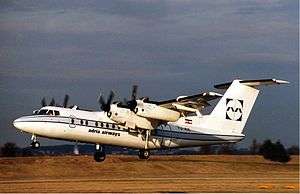 | |
| Adria Airways Dash 7 in 1989 | |
| Role | STOL regional airliner |
| Manufacturer | de Havilland Canada |
| First flight | March 27, 1975 |
| Introduction | February 3, 1978 |
| Status | Active service |
| Primary users | Various airlines Canadian Forces United States Army Venezuelan Navy |
| Produced | 1975-1988 |
| Number built | 113 |
| Developed from | DHC-6 Twin Otter |
| Developed into | de Havilland Canada Dash 8 |
The de Havilland Canada DHC-7, popularly known as the Dash 7, is a turboprop-powered regional airliner with STOL (short take off and landing) performance. It first flew in 1975 and remained in production until 1988 when the parent company, de Havilland Canada, was purchased by Boeing and was later sold to Bombardier. Bombardier sold the type certificate for the aircraft design to Victoria-based manufacturer Viking Air in 2006.
Design and development
In the 1960s, de Havilland Canada was already well known worldwide for their series of high-performance STOL aircraft, notably the very popular DHC-6 Twin Otter. However, these aircraft were generally fairly small and served outlying routes, as opposed to the busier regional airliner routes which were already well served by larger, higher-performance turboprop aircraft such as the Fokker F27, Fairchild F-27, Convair 580 and 600, and Hawker Siddeley 748.
The de Havilland Canada company felt they could compete with these designs in a roundabout way. With their excellent STOL performance, their designs could fly into smaller airports located in city centres and smaller, outlying, more austere airports having runways that the other aircraft could not easily use (unpaved, unimproved). The original specification called for a 40-passenger aircraft with a fairly short range of 200 statute miles, operating from runways only 2,000 ft long (610 m).
With new noise restrictions coming into effect throughout the 1970s, an aircraft tailored for this role would also have to be very quiet. Propeller thrust is a factor of blade length and chord and the speed at which it rotates (RPM). To meet these new regulations the new design used much larger (oversized) propellers geared to rotate at a slower speed than is normally designed. Much of the problem sound from a typical propeller is generated at the tips of the blades which are rotating just beneath the speed of sound. By using overlarge propeller blades there is no need to have the blade tip reach near the speed of sound, and the RPM can therefore be reduced without sacrificing thrust. In reducing the RPM this noise is reduced substantially. The Dash 7 often landed with only 900 RPM, and took off at only 1,210 RPM. The propellers on the Dash-7 are constant speed propellers which change the blade angle to push more or less air as needed. This can be used to change power while maintaining a constant (and lower) RPM.
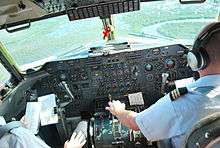
In other respects, the new DHC-7 was essentially a larger, four-engine version of the Twin Otter: the general layout remained similar, with a high aspect ratio high-mounted wing, some details of the cockpit and nose profile. Changes included the addition of cabin pressurization (requiring a switch to a fuselage with a circular cross-section), landing gear that folded forward into the inner engine nacelles and a large T-tail intended to keep the elevator clear of the propwash during takeoff (the Twin Otter's empennage was a cruciform arrangement).
The Twin Otter incorporated "flaperons" that drooped the ailerons as part of the flaps, but these were not included in the Dash 7 due to weight and complexity. Instead, the ailerons were reduced in size to allow more flap area, and were augmented with two sets of roll spoilers, or "spoilerons". The inboard roll spoilers operate at all speeds while the outboard roll spoilers only operate at speeds less than 130KIAS to allow for more roll control at slower speeds. Upon touchdown, both the inboard and outboard roll spoilers extend in unison to aid in destroying lift created by the wing. Each wing also includes two ground spoilers which only extend on touchdown. Most of the trailing edge is spanned by a complex double Fowler flap arrangement for high lift at low speed. During a typical STOL landing, flaps are selected to the 45° position, generating more lift and drag and thus allowing for steeper descents and slower approach speeds. Depending on weight, the VREF speed with flaps at 45° is between 70-85 knots. On touchdown, through "squat switches" in the main gear, the flaps automatically retract to the 25° position and thus reduce lift once on the runway producing better braking performance. The flaps also retract to 25° when engine power is increased during a go-around procedure. The four-engine layout aids lift at low speeds due to the wide span of the propellers blowing air over the wing ("propwash"). When reverse thrust is selected on landing, the props reverse pitch, push air forward and slow the aircraft very effectively along with the anti-skid wheel brakes. More importantly, if an engine fails, the asymmetric thrust is much less than on a twin-engine layout, thereby increasing safety and allowing for a lower VMC (minimum control speed) with an engine inoperative .
Operational history

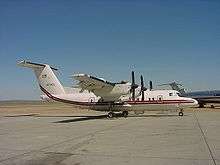
Development started in 1972 and the prototype first flew on March 27, 1975. Testing went smoothly, and the first delivery took place to Rocky Mountain Airways on February 3, 1978. The Dash 7 enabled Rocky Mountain Airways to operate scheduled passenger air service from Denver into the Avon STOLport in Colorado which was controlled by the airline. The Avon STOLport was located in a mountain valley in close proximity to the Vail ski resort. Another close-in ski resort airfield served by Rocky Mountain Airways with Dash 7 flights from Denver was Steamboat Springs Airport in Colorado. With a relatively short runway length of 4,452 feet and an airfield elevation of 6,882 feet, the Dash 7 was well suited for operations from this airport located in the Rocky Mountains.
The Kapalua Airport on the island of Maui in Hawaii was constructed specifically with Dash 7 operations in mind. According to State of Hawaii historical records, Hawaiian Airlines built this airfield and then initiated scheduled passenger flights with new Dash 7 turboprops on March 1, 1987. The airline owned this private airport, which is also known as Kapalua-West Maui Airport, until 1993 when it was acquired by the State of Hawaii. The 3000 foot runway length at Kapalua was well suited for Dash 7 operations. The three letter code for the Kapalua Airport, JHM, stands for John Henry Magoon who was President of Hawaiian Airlines when the airfield and terminal were constructed by the air carrier. Kapalua is currently served by Mokulele Airlines with Cessna 208 Grand Caravans.
One hundred Dash 7 turboprops were delivered by 1984, when the production line was put on hold in favour of the Dash 8. Another 13 were delivered between 1984 and 1988, when the production lines were removed when Boeing bought the company. The last Dash 7 was bought by Tyrolean Airways.[1]
The original Series 100 represents the vast majority of the aircraft delivered, and came in two models; the -102 passenger version and -103 combi with an enlarged cargo door. These were followed by the Series 110 which met British CAA requirements, including the -110 and -111, and finally the Series 150 which included additional fuel tankage and an improved interior in the -150 and -151. There were plans for a Series 200 with the new PT6A-50/7 engines which improved hot-and-high power, but these plans were shelved when Boeing ended production of the design.
The mixture of features on the Dash 7 met with limited commercial success. Most commuter airline turboprop operators used the aircraft as feederliners into large airports, where the STOL performance wasn't considered important. In comparison to other feederliners, the Dash 7's four engines required twice the maintenance of a twin-engine model, thereby driving up operational costs. Finally, those airports that did require a high performance STOL operation were generally small and well served by the Twin Otters; had the airport needed a larger plane to serve its customer base, they would have built larger runways. One exception to this was operations at London City Airport (LCY) which, upon opening in 1987, was capable of handling few other aircraft types besides the Dash 7 due to its relatively short runway as well as steep approach. The runway at London City Airport was subsequently lengthened and now accommodates jet operations including scheduled airline flights operated with Airbus A318 and British Aerospace BAe 146 jetliners.
The Dash 7 also gained a number of military orders. The first of these was for two aircraft for the Canadian Armed Forces, who needed them to transport high ranking passengers and freight around Europe. These aircraft received the CF designation CC-132 and were delivered to 412 Transport Squadron at Canadian Forces Base Lahr, in West Germany.[2]
The United States Army operates several Dash 7 aircraft as surveillance platforms with the designation EO-5C (RC-7B before 2004)[3] under the Airborne Reconnaissance Low program.
Transport Canada operates a single DHC-7-150IR aircraft to conduct maritime surveillance, pollution and ice patrols as part of the Transport Canada National Aerial Surveillance Program (N.A.S.P.). The aircraft's home base is Ottawa, Ontario, Canada. During the summer months this aircraft conducts patrols throughout the Canadian Arctic, Alaska and Greenland. During the fall and winter months this aircraft conducts patrols of the Great Lakes and east or west coasts of Canada as required.
The design of a much more "conventional" twin-engine design commenced at de Havilland in 1978, resulting in the extremely popular Dash 8. The DHC-7 production line eventually delivered 113, of which six have been lost and one scrapped. Many of the rest remain in service.[4]
Variants
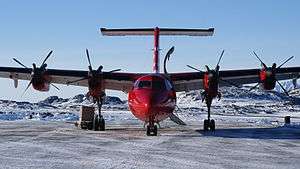
- DHC-7-1
- Prototypes, two built.
- DHC-7-100
- Production passenger variant with a maximum of 54 passengers (with 43,000 lb or 20,000 kg takeoff weight).
- DHC-7-101
- Production passenger/cargo variant with a maximum 50 passengers and a left hand forward cargo door (with 43,000 lb or 20,000 kg takeoff weight).
- DHC-7-102
- Production passenger variant with a maximum of 54 passengers (with 44,000 lb or 20,000 kg takeoff weight).
- DHC-7-103
- Production passenger/cargo variant with a maximum of 50 passengers and a left hand forward cargo door (with 44,020 lb or 19,970 kg takeoff weight).
- DHC-7-110
- DHC-7-102 certified for use in the United Kingdom.
- DHC-7-111
- DHC-7-103 certified for use in the United Kingdom.
- DHC-7-150
- Improved 1978 version with higher gross weight, increased fuel capacity and improved passenger amenities,
- DHC-7-150IR
- One series 150 modified in 1986 for Transport Canada for ice/pollution patrols of the Canadian Arctic.
- CC-132
- Canadian military designation for the Series 102/103
- O-5A ARL-I (Airborne Reconnaissance Low - IMINT)
- Converted by California Microwave Incorporated 1991-92
- EO-5B ARL-C (Airborne Reconnaissance Low - COMINT)
- United States military designation for Series 102
- EO-5C ARL-M (Airborne Reconnaissance Low - Multi-sensor)
- Converted by California Microwave Incorporated 1996
- RC-7B ARL-M (Airborne Reconnaissance Low - Multi-sensor)
- Redesignated EO-5C in 2004.
Accidents and incidents
The de Havilland Canada DHC-7 has been involved in six accidents (and 10 incidents overall) with a total of 68 fatalities.[4]
- April 28, 1982 - Aerovías Nacionales de Honduras DHC-7-103 hijacked at Le Ceiba-Goloson International Airport in Honduras with no loss of life[5]
- May 9, 1982 - Alyemda DHC-7-103 crashed into sea near Aden International Airport in Yemen killing 23 of 49 on board.[6]
- June 23, 1982 - Henson Airlines DHC-7 hijacked at Staunton-Shenandoah Valley Airport, in Virginia with no lives lost.[7]
- February 15, 1983 - Rio Airways Flight 252 DHC-7-102 hijacked at Nuevo Laredo, Mexico with none of 20 on board injured.[8]
- May 6, 1988 - Widerøe Flight 710 DHC-7-102 crashed on a hillside during poor weather near Brønnøysund Airport in Norway, killing 36 on board.[9]
- November 28, 1998 DNK Aviation Leasing Group DHC7-102 crashed after engine failed during a test flight near Ashburton, United Kingdom killing the crew of 2.[10]
- July 23, 1999 - US Army DHC-7-102 (O-5A) crashed into mountain near Orito in Putumayo province in Colombia killing all seven on board.[11]
- September 7, 1999 - Skyline (Nigeria) DHC-7-102 damaged from belly landing at Port Harcourt Airport in Nigeria with 19 on board (no fatalities).[12]
- September 4, 2002 - Asian Spirit Flight 897 DHC-7-102 slid off runway at Manila-Ninoy Aquino International Airport with 49 on board (no fatalities).[13]
- May 1, 2006 - Trans Capital Air (Toronto based charter company) for United Nations Mission in Liberia (UNMIL) DHC-7-102 crash-landed at Zwedru Airport in Liberia after landing gear failed to extend, with 40 on board (37 Ethiopian soldiers) uninjured.[14]
Operators
Airline and other operators
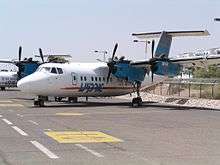
As of April 27, 2012, a total of 47 Dash 7 aircraft (all variants) remain in airline and other services.[15]
- Air Tindi (5)
- Trans Capital Air (8)
- Transport Canada (1)
- Voyageur Airways (5)
- Airkenya Express (1)
- Berjaya Air (3)
Former operators
- AirBC
- City Express
- Time Air
- Wardair (both aircraft named 'Don Braun')
- Aviones Comerciales de Guatemala (Avcom)
- Aéro Ruta Maya
- Widerøes Flyveselskap
- DNK Aviation Leasing Group
- Asian Spirit
- Zest Airways (Formerly Asian Spirit, now Air Asia Zest)
- Air Oregon
- Air Pacific (United States) (commuter airline based in California, acquired by Golden Gate Airlines)
- Air Wisconsin
- Atlantic Southeast Airlines (ASA) (subsequently renamed as ExpressJet)
- Continental Express (operated by Rocky Mountain Airways)
- Delta Connection (operated by Atlantic Southeast Airlines (ASA) and Rio Airways)
- Era Aviation (operated code share service for Alaska Airlines in Alaska)
- Farwest Airlines
- Golden Gate Airlines
- Golden West Airlines
- Hawaiian Airlines
- Henson Airlines (operated code share service for Piedmont Airlines)
- MarkAir Express (operated code share service for MarkAir in Alaska)
- Maverick Airways (operated code share service in Colorado for the current version of Frontier Airlines)
- Pan Am Express (operated by Ransome Airlines for Pan Am)
- Paradise Island Airlines
- Ransome Airlines
- Rio Airways
- Rocky Mountain Airways - worldwide launch customer
- Ross Aviation
- Trans World Express (operated by Ransome Airlines on behalf of TWA via a code sharing agreement)
Other civilian operators

The British Antarctic Survey (BAS) operates a single Dash 7 in support of its research program in Antarctica. The aircraft undertakes regular shuttle flights between either Stanley on the Falkland Islands, or Punta Arenas in Chile, and the Rothera Research Station on Adelaide Island. It also operates to and from the ice runway at the Sky Blu Logistics Facility on the Antarctic mainland.[16] A single DHC-7 150IR is owned and operated by Transport Canada conducting coastal pollution and ice patrols across the Canadian Arctic.
Military operators
- Canadian Forces (two delivered 1979 to Canadian Air Mobility Tasking for use at CFB Lahr, flown until 1987 with closure of base)[17]
- United States Army (10 - 1 O-5A, 2 EO-5B, 5 RC-7B)[17]
- Venezuelan Navy (one delivered in 1982)
Specifications

Data from Jane's All The World's Aircraft 1982–83[18]
General characteristics
- Crew: 2
- Capacity: 50 passengers
- Length: 80 ft 7 3⁄4 in (24.58 m)
- Wingspan: 93 ft 0 in (28.35 m)
- Height: 26 ft 2 in (7.98 m)
- Wing area: 860 sq ft (79.90 m2)
- Aspect ratio: 10:1
- Empty weight: 27,690 lb (12,560 kg)
- Max. takeoff weight: 44,000 lb (20,000 kg)
- Powerplant: 4 × Pratt & Whitney Canada PT6A-50 turboprops, 1,120 shp (835 kW) each
Performance
- Maximum speed: 231 knots (266 mph (428 km/h))
- Range: 690 nmi (795 mi, 1,279 km) (with 50 passengers and baggage)
- Service ceiling: 21,000 ft (6,400 m) (25.000 ft without passengers)[19]
- Rate of climb: 1,120 ft/min (6.2 m/s) (en-route, flaps and landing gear up)
See also
- Related development
- Aircraft of comparable role, configuration and era
- Related lists
References
Notes
- ↑ "Boeing de Havilland (Canada)". Flight Magazine. Flightglobal. 1989-04-29.
- ↑ "de Havilland CC-132 Dash 7." Canada's Air Force, April 6, 2004. Retrieved: August 27, 2008.
- ↑ "Non-Standard DOD Aircraft Designations." designation-systems.net. Retrieved: October 18, 2009.
- 1 2 "Aviation Safety Network Database: de Havilland Canada DHC-7." Aviation Safety Net. Retrieved: January 7, 2013.
- ↑ "Accident Report 19820428-0." Aviation Safety Net. Retrieved: October 18, 2009.
- ↑ "Accident Report 19820509-1." Aviation Safety Net. Retrieved: October 18, 2009.
- ↑ "Accident Report 19820623-0." Aviation Safety Net. Retrieved: October 18, 2009.
- ↑ "Accident Report 19830215-0." Aviation Safety Net. Retrieved: October 18, 2009.
- ↑ "Accident Report 19880506-0." Aviation Safety Net. Retrieved: October 18, 2009.
- ↑ "Accident Report 19981128-0." Aviation Safety Net. Retrieved: October 18, 2009.
- ↑ "Accident Report 19990723-1." Aviation Safety Net. Retrieved: October 18, 2009.
- ↑ "Accident Report 19990907-0." Aviation Safety Net. Retrieved: October 18, 2009.
- ↑ "Accident Report 20020904-0 ." Aviation Safety Net. Retrieved: October 18, 2009.
- ↑ "Accident Report 20060501-0." Aviation Safety Net. Retrieved: October 18, 2009.
- ↑ "DHC-7 Record." CH-Aviation. Retrieved: April 27, 2012.
- ↑ "Aircraft in Antarctica." British Antarctic Survey. Retrieved: December 31, 2007.
- 1 2 "Canadian Aerospace — Background — DeHavilland Canada Dash 7." Canadian American Strategic Review via "Archive", October 11, 2009. Retrieved: October 18, 2009.
- ↑ Taylor 1982, pp. 29–30.
- ↑ Dash 7 Approved Flight Manual
Bibliography
- Hotson, Fred W. The De Havilland Canada Story. Toronto: Canav Books, 1983. ISBN 978-0-9690703-2-0.
- Taylor, John W. R. Jane's All The World's Aircraft 1982–83. London: Jane's Yearbooks, 1982. ISBN 0-7106-0748-2.
External links
| Wikimedia Commons has media related to De Havilland Canada DHC-7 Dash 7. |
